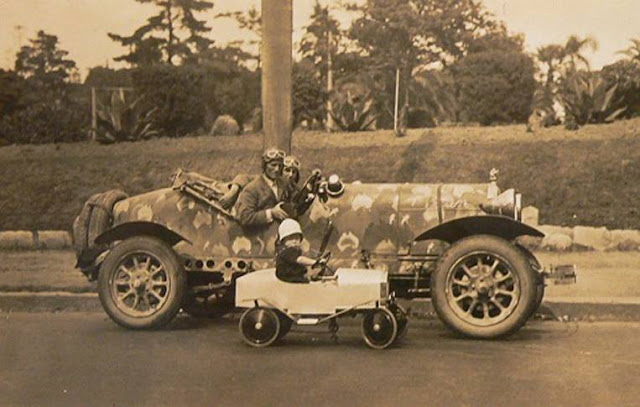Birtles and his Bean completed the fastest Australian cross-continent car journey, and the first London to Melbourne journey, a record which stood for almost 30 years.
Capitalising on the short-lived industrial prosperity of the early 1920s, Bean Cars was one company to commission Birtles as a promoter.
Based in Worcestershire and Staffordshire, this small British motor car manufacturer aimed to produce and market affordable passenger vehicles to rival Ford's popular 'Model T'.
The famous partnership with Birtles commenced in 1926, when Bean's Australian agents, Barlow Motors of Melbourne, commissioned him to drive a new two-seater Bean racing car on mostly uncharted road between Darwin and Melbourne, in the shortest possible time.
Birtles' cross-continental expedition aimed to prove suitability of British made goods in an Australian context
Eight and a half days and some 5500kms of hot and perilous country later, the travel-weary pair arrived in Melbourne to great celebration.
The journey established a record-breaking time for transcontinental travel, and proved the suitability of Bean's vehicles in the harsh Australian environment.
In keeping with the promotional aims of the journey, journalists were quick to effusively praise the car's high performance. Bearing the difficult journey in mind, the claim that Barlow never had to break out a spanner was hard to believe.
No doubt buoyed by the lavish publicity, Birtles was gifted the car by Bean in recognition of the feat.
The first London to Melbourne overland car journey comprised nine months and encompassed 26,000km, a record-breaking feat which was not surpassed until 1955.
http://www.nma.gov.au/collections/highlights/sundowner_bean_car
Cars are susceptible to metal corrosion and their painted surfaces are easily scratched. Inside the Carcoon, fluctuations in temperature and humidity are reduced and the air is filtered to prevent dust from settling on the vehicle. Dust can be highly abrasive and contain chemically active components that corrode metal surfaces over time. The Bean car was dismantled to treat structural damage and rust, but conservators were careful not to lose the physical reminders of its significant period in history. Therefore, the mud, grime, dents and scratches collected during the Birtles era have been preserved. (taken into context of the rigorous use the Bean car has been through, this is ridiculous to even mention storage time scratches and corrosion from dust... but some people are weird) http://www.nma.gov.au/exhibitions/museum_workshop/large_technology_lab
http://www.adelaidenow.com.au/ipad/intrepid-adventurers-on-the-beaten-track/story-fn6bqvxz-1225992513232
Birtles seems to have been a guy without a job, who had worked out that getting sponsors to pay for supplies was a great way to travel, and he had went on endurance runs with other cars
such as this Olsdmobile 30 he claimed a speed record with, Darwin to Adelaide, sponsored by Dunlop tires, in the mid 1910s
That was in 1912 in a single-cylinder Brush, followed in 1913 by a 5600km tour from the Gulf of Carpentaria to Melbourne in a Ford before the 1924 exploration of the Northern Territory in 1924 when the car ran out of oil.
Birtles sourced the beef dripping from an outback store, rendered it to liquid on a fire then poured it into the engine sump before driving flat out to prevent the fat from congealing.
"You smell unpleasantly, but you can still travel," wrote co-driver Malcolm Henry Ellis of the exploit.
Birtles, addicted to wanderlust, had, by 1912, cycled around Australia twice and crossed the continent seven times.
By mid-1927 he had completed more than 70 transcontinental crossings.
http://www.adelaidenow.com.au/ipad/intrepid-adventurers-on-the-beaten-track/story-fn6bqvxz-1225992513232











Tidak ada komentar:
Posting Komentar